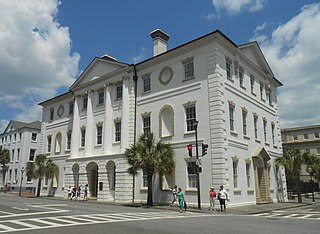
Court House Square is the location of Charleston County Courthouse in downtown Charleston, South Carolina, at the intersection of Meeting and Broad Streets. It is historically known as "the Four Corners of Law" because the intersection hosted buildings from each level of government: the Courthouse (state law), City Hall (municipal law), the Federal Building and U.S. Post Office (federal law), and Saint Michael's Episcopal Church (canon law).

Charleston County Courthouse (1790–92) is a Neoclassical building in Charleston, South Carolina, designed by Irish architect James Hoban. It was a likely model for Hoban's most famous building, the U.S. White House, and both buildings are modeled after Leinster House, the current seat of the Irish Parliament in Dublin.

Charleston is the oldest and largest city in the U.S. state of South Carolina, the county seat of Charleston County, and the principal city in the Charleston–North Charleston–Summerville Metropolitan Statistical Area. The city lies just south of the geographical midpoint of South Carolina's coastline and is located on Charleston Harbor, an inlet of the Atlantic Ocean formed by the confluence of the Ashley, Cooper, and Wando rivers. Charleston had an estimated population of 134,875 in 2017. The estimated population of the Charleston metropolitan area, comprising Berkeley, Charleston, and Dorchester counties, was 761,155 residents in 2016, the third-largest in the state and the 78th-largest metropolitan statistical area in the United States.
The Four Corners of Law is a term commonly used to refer to the intersection of Meeting and Broad Streets in Charleston, South Carolina. It was coined in the 1930s by Robert Ripley, creator of Ripley's Believe it or Not! and refers to the buildings occupying the four corners of the intersection:
- St. Michael's Episcopal Church, constructed between 1752 and 1761, stands on the southeast corner of the intersection.
- On the northeast corner of the Four Corners is Charleston City Hall, constructed in the Adamesque style between 1800 and 1804.
- Across the street, on the northwest corner, stands the Charleston County Courthouse. Originally constructed in 1753 as South Carolina's provincial capital, the building was rebuilt in 1792 for use as a courthouse.
- On the southwest corner is the United States Post Office and Federal Courthouse, built in 1896.
Charleston County Courthouse (1790–92) was designed by the Irish-born American architect James Hoban. President George Washington visited Charleston in May 1791, may have met with Hoban, and summoned the architect to Philadelphia, Pennsylvania (the temporary national capital) in June 1792. The following month, Hoban was named winner of the design competition for The White House in Washington, DC. [1]

James Hoban was an Irish architect, best known for designing the White House in Washington, D.C.

George Washington was an American political leader, military general, statesman, and Founding Father who also served as the first president of the United States from 1789 to 1797. He led Patriot forces to victory in the nation's War of Independence, and he presided at the Constitutional Convention of 1787 which established the new federal government. He has been called the "Father of His Country" for his manifold leadership in the formative days of the new nation.
The Courthouse itself is still in use, located in the historic district near the park at Washington Square. It was built on the site of and incorporated the ruins of the South Carolina Statehouse (1753, burned 1788), the capitol building for the Colony of South Carolina under British Rule. [2]

The Charleston Historic District, alternatively known as Charleston Old and Historic District, is a National Historic Landmark District in Charleston, South Carolina. The district, which covers most of the historic peninsular heart of the city, contains an unparalleled collection of 18th and 19th-century architecture, including a large number of distinctive Charleston "single houses". It was declared a National Historic Landmark in 1960.

Washington Square is a park in downtown Charleston, South Carolina. It is located behind City Hall at the corner of Meeting Street and Broad Street in the Charleston Historic District. It was known as City Hall Park until October 10, 1881, when it was renamed in honor of George Washington. The new name was painted over the gates in December 1881.

The Province of South Carolina was originally part of the Province of Carolina in British America, which was chartered by eight Lords Proprietor in 1663. The province later became the U.S. state of South Carolina.












